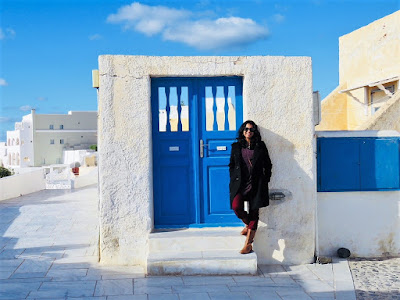How many times have you spotted little white box-like buildings against the blue sea as the 'perfect' backdrop to a cheery honeymoon couple? Chances are, all of us know at least one friend who went on their honeymoon to one of these small towns around Southern Europe, especially the Cycladic islands in Greece. My husband and I were no exception - from the day we knew our wedding date, we read and breathed stories about Santorini's white buildings, perfectly set against the gorgeous blue sea that we came to love as the 'caldera'.
A local handbook on Greek history had a different theory to this - Greek men of note were known to spend much of their time outdoor in public spaces. So they preferred massive public structures, temples and outdoor facilities. This is easy to understand, looking at the Acropolis of Athens or the numerous temples that dot the Peloponnese. But the same men lived very private and secluded family lives. Women from "good" homes were virtual prisoners and barely left their homes. This division was embodied in the windowless blank houses the Greeks built. So the white facades were not only important in protecting the inmates from the harsh weather but also symbolic of the sanctity, purity and honor of the family within. Its hard to say if the same rule applies to the public structures - Some historians argue that the public structures that we see in white today were indeed colored in red, golds and blues at some point.
I had often wondered why these buildings look that way - Its hard to imagine that ever person on those islands wanted their houses and buildings to look white. Some of the stories we heard, were rather interesting.
A common reason was that white paint was not manufactured up to the start of the 20th century. So most of these islanders used asbestos to paint their buildings (mainly due to lack of options). Now that did not quite add up, since older paintings of Santorini do have vibrant colors and hues. One story suggests that in the 19th century, Greek people painted their buildings white and blue in defiance of the Ottoman emperor banning them from flying their flag. Another story suggests that Santorini was under a military ruler in the mid-20th century, who mandated all houses to be painted white by law. The church domes that were already blue-colored were allowed to be the only exceptions. Hence the blue and white.
A common reason was that white paint was not manufactured up to the start of the 20th century. So most of these islanders used asbestos to paint their buildings (mainly due to lack of options). Now that did not quite add up, since older paintings of Santorini do have vibrant colors and hues. One story suggests that in the 19th century, Greek people painted their buildings white and blue in defiance of the Ottoman emperor banning them from flying their flag. Another story suggests that Santorini was under a military ruler in the mid-20th century, who mandated all houses to be painted white by law. The church domes that were already blue-colored were allowed to be the only exceptions. Hence the blue and white.
 |
| Blues and whites, © Janani Rajagopalan |
 |
| The entire town looks like a white and blue canvas, be it the structures, sky or the Caldera, © Janani Rajagopalan |
Its easier to understand the reason in recent times. White and blue are colors of the Greek flag and these islands have become popular 'picture-perfect' tourist destinations mainly due to their architectural beauty. So tourism and fashion have become dominant reasons for the colors of these towns today.


Interesting to read the different versions of why the Whites and Blues!
ReplyDeleteAlso, wondering, how the collective strength of an idea holds here, no individual stressing to add a splash of pink or red or green, but all ‘agreeing’ to remain within whites and blue? I wonder if due to the tourism pressures, the govt/civic authorities have made it a rule not to bring any colour.
It actually was a rule at some point in history while under rule of a monarch. My theory is that most of the folks that live here either host tourists or have little art, fashion and food stores that thrive on tourism. That may be the reason why collective preference for the white structures remains intact!
DeleteAmazing piece of content, Thank you for sharing this ideas.
ReplyDeleteSymbolic Wedding in Santorini
Santorini luxury civil wedding packages